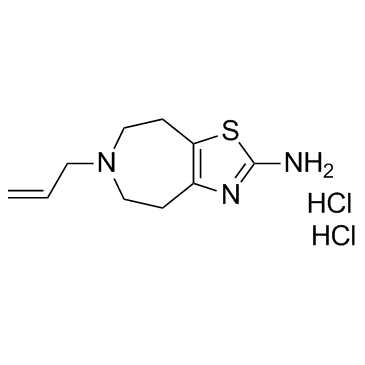Nonlinear analysis of partial dopamine agonist effects on cAMP in C6 glioma cells.
M Avalos, C Mak, P K Randall, J P Trzeciakowski, C Abell, S W Kwan, R E Wilcox
文献索引:J. Pharmacol. Toxicol. Methods 45(1) , 17-37, (2001)
全文:HTML全文
摘要
Most drugs have some efficacy so that improved methods to determine the relative intrinsic efficacy of partial agonists should be of benefit to preclinical and clinical investigators. We examined the effects of partial D(1) or partial D(2) dopamine agonists using a partial agonist interaction model. The dependent variable was the modulation of the dopamine-receptor-mediated cAMP response in C6 glioma cells selectively and stably expressing either D(1) or D(2) recombinant dopamine receptors. The dissociation constant (K(B)) and relative intrinsic efficacy (E(r)) for each partial agonist were calculated using a partial agonist interaction null model in which the effects of fixed concentrations of each partial agonist on the dopamine dose-response curve were evaluated. This model is an extension of the competitive antagonist null model to drugs with efficacy and assumes only that the log-dose--response curve is monotonic. Generally, the partial agonist interaction model fit the data, as well as fits of the independent logistic curves. Furthermore, the partial agonist K(B) values could be shared across partial agonist concentrations without worsening the model fit (by increasing the residual variance). K(B) values were also similar to drug affinities reported in the literature. The model was validated in three ways. First, we assumed a common tissue stimulus parameter (beta) and calculated the E(r) values. This provided a qualitative check on the interaction model results. Second, we calculated new relative efficacy values, E(r)(beta), using the beta estimate. Third, we calculated relative efficacy using relative maxima times midpoint shift ratios (J. Theor. Biol. 198 (1999) 347.). All three methods indicated that the present model yielded reasonable estimates of affinity and relative efficacy for the set of compounds studied. Our results provide a quick and convenient method of quantification of partial agonist efficacy. Special applications and limitations of the model are discussed. In addition, the present results are the first report of the relative intrinsic efficacy values for this set of D(2) ligands.
相关化合物
| 结构式 | 名称/CAS号 | 分子式 | 全部文献 |
|---|---|---|---|
 |
盐酸他利克索
CAS:36085-73-1 |
C10H17Cl2N3S |
|
Duration of drug action of dopamine D2 agonists in mice with...
2015-12-16 [Neuroreport 26 , 1126-32, (2015)] |
|
Mechanism of decongestant activity of alpha 2-adrenoceptor a...
2008-01-01 [Pulm. Pharmacol. Ther. 21(3) , 449-54, (2008)] |
|
Paraquat leads to dopaminergic neural vulnerability in organ...
2003-08-01 [Neurosci. Res. 46(4) , 523-32, (2003)] |
|
Impaired endothelial alpha-2 adrenergic receptor-mediated va...
2002-03-01 [Hypertens. Res. 25(2) , 197-202, (2002)] |
|
Blood pressure and alpha-vascular reactivity in hypertensive...
2004-04-05 [Eur. J. Pharmacol. 489(1-2) , 101-10, (2004)] |